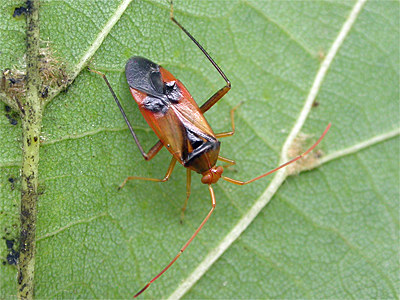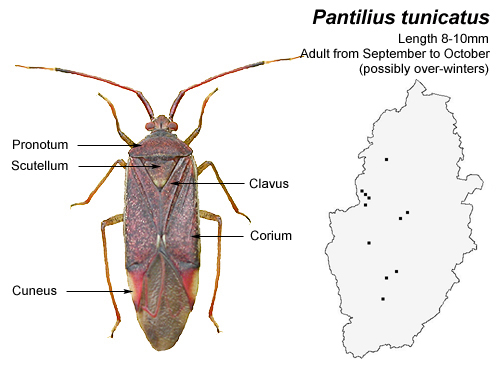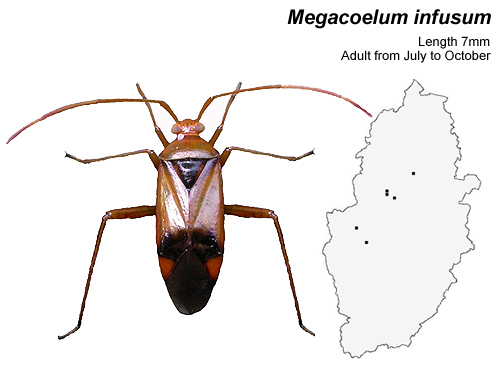

| Two late season Mirid Bugs |
| ... |
| Towards the end of the
Summer months and with Autumn fast approaching, many of
our native Bugs have completed their adult lives, or are
readying themselves for over-wintering. But there are two Mirid Bugs just reaching their peak activity in September. Both are found in Nottinghamshire, both are quite large, easy to identify and probably under-recorded. We still actually know very little regarding the distribution of much of our Homoptera (Leafhoppers, Treehoppers etc) and Heteroptera (Squashbugs, Groundbugs, Mirid Bugs etc) in Nottinghamshire. So we hope that by creating an awareness that there are species to be found later in the year, we may obtain a better picture of their distribution as a result. |
 |
|
| ... | ||
| Pantilius
tunicatus (Fabricius, 1781) and Megacoelum
infusum (Herrich-Schäffer, 1837) are distinctive,
large and colourful Mirid Bugs. Of the two, records would
suggest that Pantilius tunicatus is much the
commoner of the two species, with an increasing number of recordsover
the past few years. Most records are from rural habitats, but it
obviously occurs in
parks and even large gardens which are well planted with a range
of shrubs.
Megacoelum infusum is quite the opposite and was once thought to be probably restricted to mature Oak woodland, but an increasing number of records (especially in 2020 and 2021) show that it may well prefer more isolated Oaks, including those growing in older town parks. |
||
| ... | ||
| Pantilius tunicatus (Fabricius, 1781) |
Nottinghamshire status and distribution: Reasonably common across much of the UK, but its present status is unknown in Nottinghamshire. The number of records we have had within a few years would suggest that it is quite common. However, we have not received records of Pantilius tunicatus from any other entomologists in the county. The only records we have personally, all refer to adults and include five at Gedling Pit Top October 11th 2012, one at Nettleworth Manor near Mansfield Woodhouse on October 29th 2012, two at Nether Langwith Quarry on November 5th 2014, one at Manton Pit Wood (Worksop) on September 6th 2015 and one at Warsop Main Pit Top on September 23rd 2015. Since 2015, it has turned up on a number of occasions, including at MV light traps and is either on the increase, or there is increased awareness/interest among recorders. Flight period: Emerges as an adult in August and can be found until October. It can ccasionally be recorded in November and it may over-winter as an adult. We have recorded it on five occasions in recent years, between September 6th and November 5th. |
 |
|
| ... | ||
| Identification
features: This is a large and very attractively
coloured Mirid Bug, appearing much later in the year than
most species, which helps to narrow down any
identification pitfalls. Colouration ranges from mostly
green, through to reddish (almost purple in some light)
but this depends on age, with fresher examples being the
greener. Often the most contrasting colouration is found
on the Cuneus, which can be 50/50 green and red. In the specimens we have seen, the colouration of the Pronotum, Clavus and Corium has been the same, but the Scutellum often shows some lighter colouration. The Antennae are long and distinctive (but never longer than the body) the first section being of similar colouration to the Pronotum, Clavus and Corium. The end of the antennae is conspicuously banded with yellow. Foodplants: Pantilius tunicatus and can be found on Hazel, Alder and Birch. Most of our records have been recorded on Hazel. |
||
| Megacoelum
infusum (Herrich-Schäffer,
1837) |
Nottinghamshire status and distribution: Seemingly rare in Nottinghamshire, but as is often the case with many of our invertebrates, there may be an element of under-recording. With so much Oak, this Mirid should be expected to occur widely over the Sherwood Forest area, but there are no historical records listed by J.W. Carr in his 1916 publication "The invertebrate fauna of Nottinghamshire". Currently, Nottinghamshire's only record refers to one which was beaten from Oak at Sherwood Heath SSSI near Ollerton on September 30th 2015. There are several recent records from Budby South Forest, Ravenshead (Dave and Veronica McGeever) and Mansfield Cemetery. Flight period: This is another Mirid Bug to appear in the latter part of the Summer, usually from July through to October. Identification features: Megacoelum infusum is a distinctively large, long-legged and distinctively bright orange Mirid Bug and there are few other species around to possibly cause any real identification difficulty. |
 |
|
| ... | ||
The antennae, head, Pronotum and all but the very ends of both the Clavus and Corium are orange. The exposed wing membrane is dark brown to almost black, this colour extending up through the Cuneus (which has a distinct red patch) and just into both Clavus and Corium. The Scutellum is distinctively dark, about the same colour as the exposed wing membrane. Foodplant: Oak is the preferred foodplant, but small insects are occasionally included in their diet. |
||